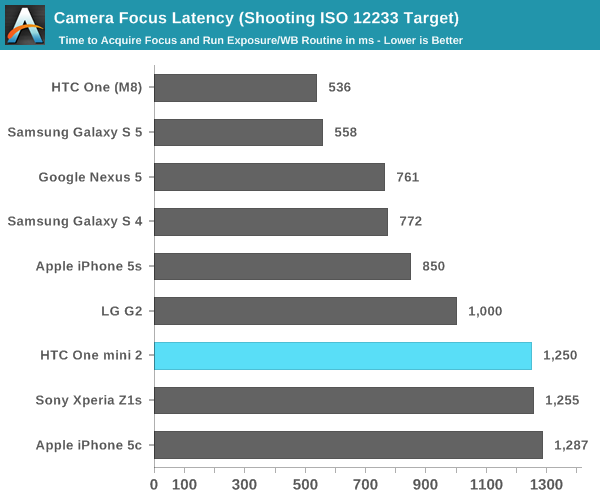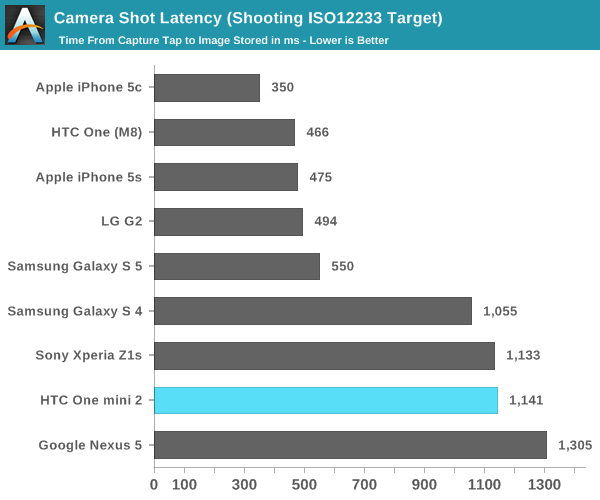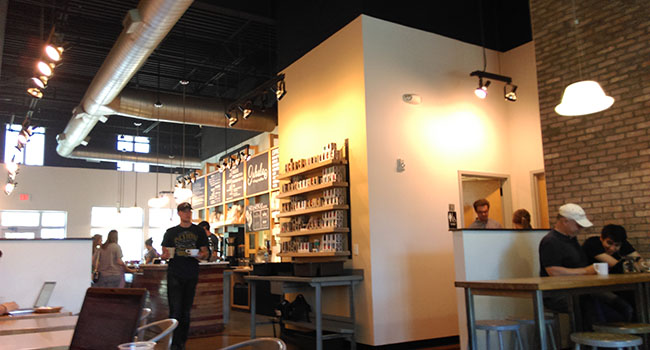HTC One mini 2 Review
by Anand Lal Shimpi & Joshua Ho on May 26, 2014 3:00 AM EST- Posted in
- Smartphones
- HTC
- Mobile
- One mini 2
Focus & Capture Latency
Although image quality is a (big) part of the camera experience, camera UI and capture latency in particular are quite important. Long focus and capture latencies can really ruin the overall experience, not just from a responsiveness standpoint but also by contributing to missing a shot. At the very high end, devices like the One (M8) and Galaxy S 5 rely on external companion chips to improve focus times. In the transition to a lower price point, the One mini 2 loses any external imaging aids.
Though the camera UI looks similar to the M8's, it's very obvious that both focus and capture latency are substantially longer on the One mini 2. To quantify the difference I turned to the set of tests we introduced in the Galaxy S 5 review.
First let's look at focus time. I measured from the moment I tapped the focus target to the time the image stopped moving (I didn't rely on the AF lock indicator as some devices report focus lock prematurely). There's a bit more variance than I'd normally like in these numbers due to the nature of the capture, although I'm working on getting a higher speed camera to smooth some of that out.

The lowest focus latency I saw on the mini 2 was 850ms, but on average I saw around 1.2 seconds from tap until focus lock. That's about the speed of an iPhone 5c, but substantially slower than other similarly priced devices like the G2.
Focusing is just one piece of the puzzle, I also measured capture latency as well. I had to modify my criteria for measuring latency here a bit. Previously I just looked at the time between when I tapped the capture button on the screen and when the camera UI was ready to take another shot. For all other devices, that metric worked out fine - the mini 2 behaves a bit differently. The UI is responsive after about 250ms. In fact, on the mini 2 you can queue up to three captures in a row. The problem is the image captured won't be committed to NAND (and thus unavailable for review) until around 1100ms after you hit the capture button. The UI is still responsive during that time, but you haven't really completed a capture. What I'm looking at in the graph below is the time between capture tap and the image being stored.

The One mini 2 takes a bit over a second to complete a capture, which definitely hampers the experience. HTC does a good job of keeping the UI feeling responsive though. If you don't mind the image actually not being committed to NAND, the mini 2 provides the appearance of a 250ms capture latency.
This next chart combines the previous two values to give an overall picture of capture latency on these devices:

The One mini 2 ends up being our slowest device here. Even if you use the lower value for capture time, the mini 2 ends up around the middle of the pack. I suspect the Snapdragon 400's ISP definitely hampers performance here.
Still Image Summary
The One mini 2 definitely has the ability to deliver more detailed photos than the One (M8) in well lit scenes. For landscape shots or photos where a detailed subject is far away, the One mini 2 maintains an advantage over the M8. With subjects up close however, the advantage is far less pronounced and in many cases goes back to the M8:


Any advantage in spatial resolution the mini 2 maintains however comes at the expense of low light performance, which is more or less nonexistant on the mini.
In shooting with the mini 2 I definitely noticed more issues with blurring at the corners and a lack of uniformity overall, which is usually what we get with lower cost camera modules. Even my M8 sample shows more distortion on one side of the module than on the other.
Compared to other similarly priced devices, the One mini 2 generally falls behind in still imaging performance. You can find LG's G2 for around $400 now, which not only produces better photos in well light scenes but much better photos in low light as well.
Capture latency is also worse on the mini 2 compared to the M8. Focus and capture times are longer than previous generation flagships like LG's G2 as well. Despite the long capture time however, HTC does a good job of making the camera UI still feel responsive.
Video
The One mini 2 can capture high profile H.264 at 1080p30 with an average bitrate just south of 20Mbps. The device can also capture captures H.264 (baseline profile) video at 720p30 with an average bitrate of 11.8Mbps.

Video quality isn't particularly great, but it's usable so long as there's sufficient light.










76 Comments
View All Comments
Laxaa - Monday, May 26, 2014 - link
It baffles me that this "mini" is the same size as the M7. What does this offer that the M7 don't have on a lower price point?fokka - Wednesday, May 28, 2014 - link
slightly better battery life, slightly better camera in daylight, sd slot.Morawka - Monday, May 26, 2014 - link
i like last year's metal unibody much better than this. Satin aluminum feels much better in the hand, (and looks better) than this brushed aluminum look.krazyfrog - Monday, May 26, 2014 - link
The brushed aluminum finish is only on the grey model. The silver and gold look like the M7.fokka - Wednesday, May 28, 2014 - link
i also like the m7 design better, but not because of the brushed finish - i love brushed metal! - but the corners look better imho. it doesn't look all that rounded, more simple and also the top speaker grille is more centered. also the speaker grilles were real metal on the m7 and if you look closely at the m8 you can see that theres a rather thick clear coat on the grilles, plus not all holes are drilled all the way through. "nitpicking", yes, but on a phone that lives for its design i think those are still valid points.also the second (duo-) camera looks goofy and the black m7 is just absolutely gorgeous, compared to the black m8 with its appalling gold speaker grilles (sprint version).
also (sorry for saying "also" so much!), i don't get how they get their numbers like "90% metal", or "50% metal". shure, the surface of the m8 features a couple percent more metal than the m7, but not to the extent of 90% vs. 70%. and the mini 2 sure as hell isn't down to only 50%. i'm really wondering how they calculate this to get those numbers.
SetiroN - Monday, May 26, 2014 - link
You are being WAY too kind.These "mini" marketing devices deserve to be bashed and put to shame. People buy them thinking they're getting a mini flagship and end up hating android.
This is a terrible device at that price point.
Laxaa - Monday, May 26, 2014 - link
It is. The M7 is a much better buy. It might be a year old, but it's still a great smartphone. It looks better as well.hangfirew8 - Tuesday, May 27, 2014 - link
Exactly what I was thinking! If they had put an 8MP camera on the M7 it would have been a better phone than this.fokka - Wednesday, May 28, 2014 - link
the m7 with a larger 8mp sensor with OIS and an sd slot would have been perfect!! plus the sd801 from the m8 to seal the deal and they would have one customer more.r3loaded - Monday, May 26, 2014 - link
4.5 inches is "mini" now?